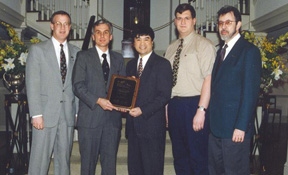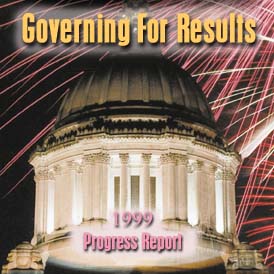 Cover photo by Halverson
Fine Photography
Cover photo by Halverson
Fine Photography |

Taxpayers have demanded a better
government and state workers have listened and are working hard to gain
the public's trust. State agencies are continuing to make improvements
to our government that save us money, generate revenue and provide better
service to all of us.
I applaud each agency's contributions
to the quality of service we offer and commit to you that these efforts
will continue. Our goal remains firm: "Make government work better…"

Governor Gary
Locke
September, 1998
|
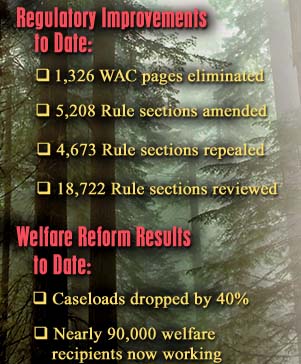 |
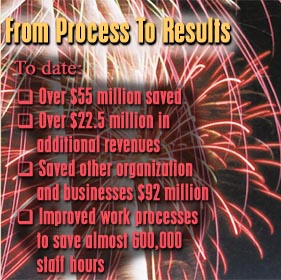 |

In April of 1997, Governor
Locke issued an Executive Order directing all state agencies to develop and
implement a program to improve the quality, efficiency and effectiveness of
the public services they provide.
Everyone is involved - agencies,
employees, labor, businesses, and taxpayers. The mandate is simple - find out
what is not working well and fix it. Quality improvements and regulatory reform
go hand in hand, with a focus on improving customer service.
Employees have been encouraged to
be creative, to have ownership of their work, to be innovative and use technology
to better serve the citizens of our state.
This report reflects the progress
made through December 1999. The teams presented here won the Governor's Quarterly
award for Service and Quality Improvement in 1999. They best describe the diversity
and depth of improvements that are happening throughout state agencies.
FOR MORE INFORMATION
ABOUT THIS PROGRAM, CONTACT:
René Ewing
Special Assistant for Quality Improvement
360/902-0586 - Fax 360/664-2832
January, 1999
DEPARTMENT OF SOCIAL AND HEALTH SERVICES,
Improved Case Management for Long Term Care Clients
Annual audits conducted by Aging and Adult Services Administration (AASA)
staff indicated a number of inaccuracies in client records. A project team
used a special monitoring tool to find forty-one common problem areas identified
by social workers and community nurse consultants. The team used existing
staff with profound knowledge to provide in-depth, targeted training on
each. The monitoring tool documented a 71% improvement in accuracy and a
100% increase in accuracy on calculations of client care costs. Financial
staff also determines eligibility 10 minutes faster per case, resulting
in 700 staff hours saved each month. |
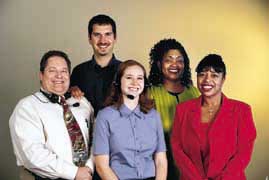 |
October, 1999
EMPLOYMENT SECURITY DEPARTMENT,
WorkFirst Post Employment Labor Exchange (WPLEX) Team
The philosophy of Washington's WorkFirst Program is "Get a job, get a better
job, get a better life". An inter-agency team designed the WPLEX automated
telephone call center. Staff work with former TANF (Temporary Assistance
to Needy Family) welfare recipients providing resources, training and better
pay. The program resulted in more than 17,000 clients achieving some level
of wage progression at work and 6,000 referrals to Community Colleges for
training assistance. Another 4,000 clients were identified with job retention
issues and referred to case managers for assistance. WPLEX is showcased
as a national best practice. |
|
October,
1999
HUMAN RIGHTS COMMISSION,
QIC Case Processing Sub-Committee
This team eliminated a decade-old backlog of discrimination complaint
cases. They streamlined agency practices to abolish unnecessary work and
inefficient processes and developed a system for prioritizing and processing
cases efficiently and competently. Overall case inventory was reduced
by nearly 75% since July 1996, effectively eliminating case backlogs.
The number of cases older than one year was reduced by nearly 90%. In
1996 only 20% of cases were closed in 6 months, now more than 60% are
closed in the same timeframe.
|
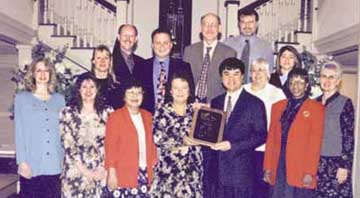 |
January, 1999
DEPARTMENT OF LABOR & INDUSTRIES,
Electrical Inspector's Area Redesign Team
Inspectors conducted a customer survey and found that contractors would
like more timely and predictable inspections. The team revised territory
assignments based on numbers of requests and travel time required. Now inspection
results are faxed to contractors the next morning, territories are covered
more evenly and inspectors work more collaboratively. Electrical inspectors
redesigned inspections and went from 67% to 86% completed within 24 hours.
Stakeholders don't wait as long for electrical inspections and work-site
safety was enhanced when electrical equipment and trenches closed sooner.
|
 |
July, 1999
DEPARTMENT OF SOCIAL AND HEALTH SERVICES,
LifeBook Project
Most of us have "Baby Books" lovingly prepared by parents to chronicle
childhood and give a sense of identity and belonging. Most kids leaving
foster care had no such record of early life experiences. The LifeBook Project
Team developed a "how-to-create a LifeBook manual" for compiling stories,
pictures and documents from a child's personal history. The manual contains
sample paragraphs about sensitive adoption issues, written in a healing
manner. It saves workers and volunteers many hours in preparation and allows
75% of foster kids the opportunity to take a legacy with them to their new
adoptive home. |
April, 1999
DEPARTMENT OF HEALTH,
Vaccine Distribution Team
The Vaccine Management and Distribution Center handles millions of dollars
of product annually and faced increased demand and a rising numbers of new
vaccines. Customer feedback indicated that vaccines were spoiling due to
shipment delays causing customers to hoard product. The team identified
more than 50 vital operational functions - some poorly organized with inadequate
resources and outdated equipment. They improved vaccine distribution, and
turnaround times were reduced from 20 days to five. Additionally, local
health jurisdictions are able to access training and technical support so
that logging errors have been virtually eliminated and vaccine spoilage
has dropped to one percent! |
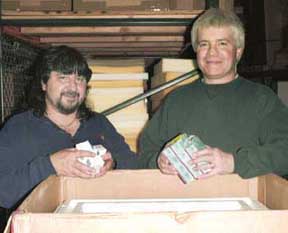 |
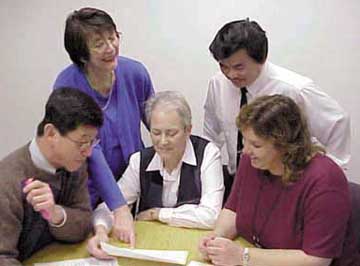 |
April, 1999
DEPARTMENT OF RETIREMENT SYSTEMS,
Receivables Management Project Team
The agency's old receivables management system was outdated and would
not fully interface with other DRS systems. Employer customers would sometimes
receive multiple statements or statements difficult to reconcile with corresponding
invoices. These problems required considerable staff time to resolve for
both the DRS and their customers. A 24-member team designed and implemented
a brand new Receivables Management System. Employees now have better access
to current data and employers are happy about spending less time reconciling
accounts. The best news was that lower operating costs generated an additional
$500,000 in interest and earnings to the pension fund. |
July, 1999
DEPARTMENT OF AGRICULTURE,
Abuela Project
In 1997, more than 90 cases of Salmonella occurred among Hispanic children
in Yakima County. It was traced to "queso fresco," a traditional soft-white
Mexican cheese food, produced from raw unpasteurized milk and untreated
animal gut. The Department of Agriculture, WSU Cooperative Extension Service
and Yakima County Health District formed a coalition. Named the "Abuela
(Spanish for Grandmother) Project," they developed a community-based team
of Hispanic volunteers to educate people about health risks and provide
safe alternatives to traditional recipes. Hundreds of residents were trained
and the project has expanded to six counties resulting in only two reported
infections since! |
 |
April, 1999
DEPARTMENT OF SOCIAL & HEALTH SERVICES,
Alpha Collection Team 14, Division of Child Support
Low collection rates and morale caused this team high absenteeism and turnover
and poor customer service. Alpha Collection Team 14 designed a process to
simultaneously review cases for collection enforcement and training. They
set a goal to increase collections 45%, reduce overdue reviews 60%, and
increase the percent of paying cases and dollars collected per case. This
new attitude and process allowed the team to exceed targets and dramatically
improve morale. Their efforts are a model to other DSHS teams. |
July, 1999
DEPARTMENT OF INFORMATION SERVICES,
Portfolio Management Team
State government's stewardship of information technology is the Department
of Information Services (DIS). They wanted to boost the successes of state
agencies on major information technology projects. A team collaborated with
customers to design a "portfolio management tool," allowing agencies the
benefit of monitoring information technology projects using their own standards.
They streamlined a 16-page survey down to three pages. Portfolio Management
was formally codified in statute by the 1999 Legislature and named the "most
innovative computing project in American business" by the Maxwell School
of Citizenship at Syracuse University. |
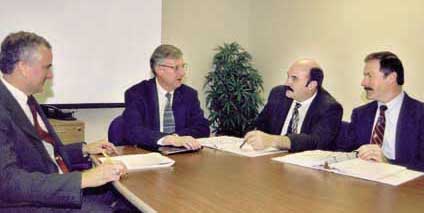 |
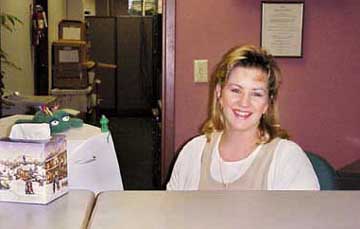 |
July, 1999
DEPARTMENT OF LICENSING,
Master License Service (MLS) Team,
With the cooperation of the IRS and four state agencies, the Department
of Licensing improved the one-stop process for registering and licensing
new businesses. Washington became the first state or federal entity to provide
the immediate issuance of Federal Employer Identification Numbers (FEIN).
While other states average four weeks, preliminary FEIN assignments now
occur at 48 Unified Business Identifier service counters. This program greatly
reduces the number of contacts, phone calls and excursions associated with
starting a new business. In a recent survey, 84% of the FEIN customers rated
the program satisfactory or better. This improvement was honored with Vice
President Gore's "Hammer Award." |
|
January,
1999
WASHINGTON STATE SCHOOL FOR THE BLIND (WSSB),
Computer Access throughout Washington
As graphic interfaces make software user-friendlier for the sighted, access
for blind students became nearly impossible. The technology team at WSSB
worked with teachers to standardize software and write interfaces that
modified Windows. As Helen Keller said, "While they were saying it cannot
be done, it was done." Washington blind children were the nation's first
to access standard software on PowerPoint and the Internet. WSSB provides
school districts with software specifically designed for visually impaired
children, teacher training and ongoing technical support. It all results
in increased literacy and learning opportunities for kids.
|
|
April, 1999
EMPLOYMENT SECURITY DEPARTMENT,
Alien Employment Certification Program
The Alien Employment Certification Program, which approves employment of non-U.S. born workers to industries struggling to fill high demand positions, suffered major funding cutbacks in 1998, cutting staff from 6 to 2. This team refused to wallow in circumstances they couldn’t control, took initiative and came up with a new automation system. They also began an innovative process to assist employers with alien employee recruitment for jobs difficult to fill with U.S. born workers, particularly for high tech manufacturers. Additionally, the team reduced per case processing time even with dramatic increases in application numbers.
|
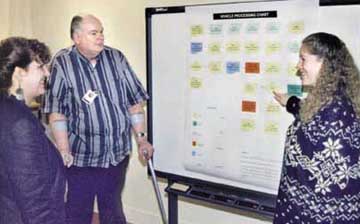 |
January, 1999
DEPARTMENT OF GENERAL ADMINISTRATION,
Vehicle Order Contract Process Improvement Team
The team decided their manual processes were labor intensive and chose technology
to streamline them. The new method eliminated printing and postage by faxing
or e-mailing vehicle orders to vendors and customers. The process reduced
staff time by 967 hours per year and response time was improved from 5 days
to 1 day for both customers and suppliers. Steps were reduced from 13 to
6 and the number of people involved decreased from 8 to 3. |
January, 1999
DEPARTMENT OF ECOLOGY,
TurboWaste
Approximately 7,500 companies report hazardous waste disposal and handling
information to Ecology each year. The volume of annual information was increasing,
resulting in longer time frames to obtain, analyze and report trends in
hazardous waste management. Staff came up with the idea of TurboWaste, an
electronic reporting system. TurboWaste reduced reporting times from 18
months to 6 months, paper reporting 86%, data requirements 25%, the cost
of administrating annual reports, and the reporting burden on businesses.
|
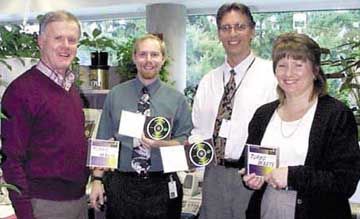 |
January, 1999
DEPARTMENT OF LABOR & INDUSTRIES,
Contractor Registration Process Improvement Team
In the past, contractor renewal processes were inefficient resulting in
jobs lost by contractors. Renewals were sorted in the mailroom and left
piled in pending stacks awaiting additional information. Contractors had
to wait for their renewal before taking on new work. The team streamlined
the Contractor Registration renewal process from 27 days to 1 day. This
prevents contractors from losing jobs due to the untimely processing of
renewal paperwork. Staff saved 1.5 hours per day due to reduced backlogs
and, with no more sorting, the mailroom staff saved 2.5 hours a day. |
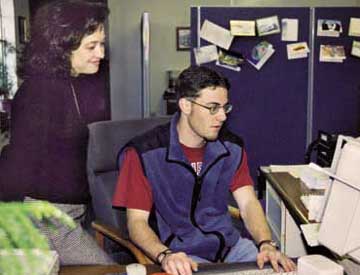 |
July, 1999
POLLUTION LIABILITY INSURANCE AGENCY,
Liability Reinsurance Program
Owner/operators of underground petroleum storage tanks are required to demonstrate
financial responsibility for cleanup costs. In many situations, insurance
was not available or costs were prohibitive. The Pollution Liability Insurance
Agency is charged with finding an affordable reinsurance program. Since
inception, the premiums per tank site have dropped by more than 60%. A typical
premium payment in Seattle decreased from an average $8,250 to $3,251 annually.
Statewide, policyholder savings were reported at more than $2.5 million.
The Environmental Protection Agency and the Association of State and Territorial
Solid Waste Management Officials chose the PLIA "the best and most successful
underground tank storage program in the nation." |
January, 1999
DEPARTMENT OF GENERAL ADMINISTRATION,
Capitol Lake Rail Yard Recycle Team
GA had to dispose of 4,000 feet of railroad track to proceed with Heritage
Park construction. Standard procedure was to pay a private contractor to
do the work and profit from the salvage of steel rails and railroad ties.
With the Department of Corrections, they trained inmates on heavy equipment
to separate and load rails. Then GA coordinated with the National Guard
to transport steel and rail ties to salvage. Some ties were used for landscaping
at the School for the Deaf. The team generated $15,000 revenue, avoided
$34,000 disposal costs and saved other agencies $22,500 in rail tie expense. |
July, 1999
DEPARTMENT OF VETERAN'S AFFAIRS,
Veterans Incarcerated Program (VIP)
More than half of King County's incarcerated veterans were African Americans
with untreated drug and alcohol issues, homelessness, poverty and Post Traumatic
Stress Disorder. The Department of Veteran's Affairs coordinated efforts
with King County to provide vets with temporary housing, employment services
and treatment referral. The program reduced the recidivism (return to prison)
rate for program participants to less than 10% compared to nearly 40% for
those not accessing services. Dollar savings measured over 12-months exceeded
$835,000 and similar programs were launched in Snohomish and Pierce Counties. |
October, 1999
DEPARTMENT OF ECOLOGY,
Whatcom Watersheds Project
The goal of the Watersheds Project is to protect rivers, lakes, streams
and groundwater resources in Whatcom County. It exists as a public-private
partnership, educating the public and changing behaviors. In Bellingham,
300 businesses along with 500 households and city departments pledged to
protect Whatcom Creek. The department surveyed businesses and households
and found that most had reduced polluting behaviors as a result of the pledge.
In fact, 23% reported changing four or more polluting behaviors. A car wash
kept an estimated 60,000 gallons of soapy water out of the creek and the
city's new oil filter crusher eliminated additional contamination. |
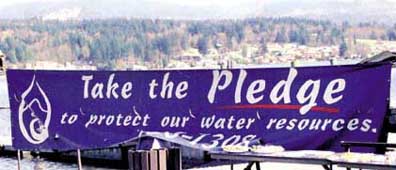 |
April, 1999
DEPARTMENT OF REVENUE,
Geographic Information System (GIS)Team
Team With varying tax rates and frequently changing city/county boundaries,
Revenue was forced to deal with error rates in excess of 30% from Washington
businesses. Compelled to make reporting of business taxes simple and consistent,
the team analyzed trends that were affecting tax-coding processes. The outcome
was a Geographic Information System (GIS) on the Internet allowing taxpayers
free access to proper coding by location(s). No other state has a comparable
application. Revenue's solution influenced a national commission studying
how taxes get applied to Internet sales by offering methods of determining
rates for companies conducting business in multiple states. The best news
- they now report an error rate of less than 5% for GIS accounts. |
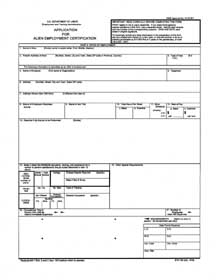 |
January, 1999
EMPLOYMENT SECURITY DEPARTMENT,
Performance Measurement Process Improvement Team
ESD needed a standardized, visual electronic tool for capturing critical
performance measurement information agency-wide, in an efficient and readily
accessible manner. The team conducted research then tested and fine-tuned
a series of linked spreadsheets. The resulting template is available on
the department's wide-area-network (WAN) and is electronically linked to
a one-page master report of graphs, quantitative data and narrative information.
Their effort has resulted in increased efficiency, reduced labor costs and
the elimination of redundancies. Data is readily accessible to management
to support better decision making. |
July, 1999
DEPARTMENT OF SOCIAL AND HEALTH SERVICES,
Improving Medication Distribution at Western State Hospital
It took 200 hours to refill patient medications at Western State Hospital.
Nurses performed pick ups and deliveries, medications created storage problems
and wards experienced downtimes while prescriptions were being filled. These
issues created confusion and errors in medication dispensation. Hospital
pharmacy, nursing and computer staff analyzed the process and determined
methods for improvement. They decided to purchase an automated unit-dosing
dispensing machine, which fills prescriptions at near 100% accuracy using
easy-open packets. Pharmacy staff deliver and refill medications in less
time and allow nurses relief from the process. The equipment uses less expensive
bulk medications, so the hospital saves another $50,000 annually! |
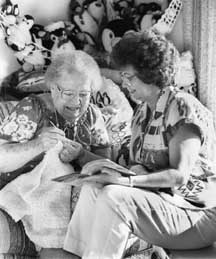 |
January, 1999
DEPARTMENT OF SOCIAL AND HEALTH SERVICES,
Nursing Facility Rate Setting Process
The Aging and Adult Services Administration had legislative mandates to
develop a new Nursing Facility Medicaid payment system. An Office of Rates
Management team examined ways to streamline and consolidate work. They noted
that existing payment systems took five years for final resolution of allowable
costs and that an entire unit worked its lengthy "settlement" process. By
redesigning functions, payments are now completed in two years or less.
Drawn-out settlement processes were eliminated. $15 million in unallowable
costs was identified for one year, producing direct program savings and
reduced nursing home payment growth. |

Washington State continues
to seek innovative ways to use the Internet to serve citizens. It is the
leading state in implementing digital technologies and it has won the
"Digital State" award from the Progress and Freedom Foundation
two years in a row. Government Technology magazine named Access
Washington - the state's Internet portal -- Best State Government
Web Site, while Internet Week and Network Computing magazines
honored the state with a Business on the Internet award for Best Public
Service Site. In 1999, Washington received three National Association
of State Information Resource Executives awards for outstanding achievement
in the field of information technology:
- Service Applications:
Access Washington, the state's Internet web portal
- Networking: K-20
Educational Telecommunications Network, linking the schools and educational
institutions throughout the state
- Administrative Applications:
Data Warehouse, on-line human resource personnel data for state employees
Our digital government goal
is to bring citizens and business easy Internet access to government information
and services.
Current Services Available
on the Internet:
|


![]()










